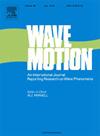(3+1)维散焦Gardner-KP方程的精确解
IF 2.5
3区 物理与天体物理
Q2 ACOUSTICS
引用次数: 0
摘要
本文试图对(3+1)维离焦Gardner-KP方程进行严格而全面的群分析。根据李不变性条件,得到了由8个向量场张成的无限小对称的李代数。导出了对易子表和伴随表,给出了搜索一维子代数最优系统的详细过程。在最优系统中,利用无穷小生成器得到了几个具有物理或数学意义的对称约简和群不变解。利用幂律非线性二阶椭圆方程的有效不变解和解,导出了一类新的特解。特别是,通过将简化的二维对应方程转换成Hirota的双线性形式,发现了基本孤立波。并给出了一种特殊的平顶孤子激励。还证明了该(3+1)维方程只能有单向多孤子解,并且不允许发生孤子共振。通过数值模拟,用三维图形说明了所得解的物理解释。不同类型的双孤子相互作用也用图形的方式进行了演示。本文章由计算机程序翻译,如有差异,请以英文原文为准。
New exact solutions of the (3+1)-dimensional defocusing Gardner–KP equation using Lie symmetry analysis
In this paper, an attempt is made to present the rigorous and comprehensive group analysis of the (3+1)-dimensional defocusing Gardner–KP equation. According to the Lie invariance condition, the Lie algebra of infinitesimal symmetries spanned by eight vector fields is found. The commutator and adjoint representation tables are derived, and a detailed process for searching the optimal system of one-dimensional subalgebras is shown. Several symmetry reductions and group-invariant solutions with physical or mathematical interests are obtained by using infinitesimal generators in the optimal system. Some new particular solutions are deduced by using effective invariant-solution ansatz and the solutions of a second-order elliptic equation with power-law nonlinearity. Especially, by recasting the reduced two-dimensional counterpart equation into Hirota’s bilinear form, the fundamental solitary waves are found. And a special kind of flat-top soliton excitation is exhibited. It is also shown that this (3+1)-dimensional equation can have only unidirectional multiple-soliton solutions and does not allow soliton resonance to occur. The physical interpretations of resulting solutions are illustrated by three-dimensional graphics through numerical simulation. Different types of two-soliton interactions are also demonstrated in graphical ways.
求助全文
通过发布文献求助,成功后即可免费获取论文全文。
去求助
来源期刊

Wave Motion
物理-力学
CiteScore
4.10
自引率
8.30%
发文量
118
审稿时长
3 months
期刊介绍:
Wave Motion is devoted to the cross fertilization of ideas, and to stimulating interaction between workers in various research areas in which wave propagation phenomena play a dominant role. The description and analysis of wave propagation phenomena provides a unifying thread connecting diverse areas of engineering and the physical sciences such as acoustics, optics, geophysics, seismology, electromagnetic theory, solid and fluid mechanics.
The journal publishes papers on analytical, numerical and experimental methods. Papers that address fundamentally new topics in wave phenomena or develop wave propagation methods for solving direct and inverse problems are of interest to the journal.
 求助内容:
求助内容: 应助结果提醒方式:
应助结果提醒方式:


